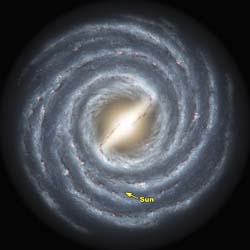Getting an overview of our own galaxy is tricky work. After all, we live in one of its spiral arms, so we see through a swarm of surrounding stars that mask the true galactic shape. Astronomer Ed Churchwell at the University of Wisconsin describes the effort as an attempt to define the boundaries of a forest from a vantage point deep within the woods.
 But when it comes to stars, changes of wavelength can help. Working in the infrared, the Spitzer Space Telescope can see through intervening clouds of interstellar dust to the Milky Way’s dazzling center. Churchwell and team’s latest work is a survey of 30 million stars using Spitzer data that has revealed details about what the Milky Way looks like from the outside. The picture, as shown in the illustration, is a bit different than we had been led to expect.
But when it comes to stars, changes of wavelength can help. Working in the infrared, the Spitzer Space Telescope can see through intervening clouds of interstellar dust to the Milky Way’s dazzling center. Churchwell and team’s latest work is a survey of 30 million stars using Spitzer data that has revealed details about what the Milky Way looks like from the outside. The picture, as shown in the illustration, is a bit different than we had been led to expect.
For cutting through the galactic center is what Churchwell calls a “long central bar.” Other galaxies have been observed with stellar bars — large bodies of gas, dust and stars. In fact, approximately one-third of all spiral galaxies are barred. No one is exactly sure how the bars form, but they seem to rotate as if they were solid objects and have the effect of channeling interstellar gas inward toward galactic center.
Within a bar, stars no longer follow circular orbits but move in more radial orbits that pass through the center of the galaxy. Suspicions had been growing that the Milky Way was a barred galaxy, but this new study seems to confirm the theory. The Milky Way’s bar consists of relatively old and red stars in a band perhaps 27,000 light years in length, longer than any previous estimates. In this era, the bar is tilted at about a 45 degree angle relative to a line between our own Sun and the center of the galaxy.
Churchwell’s team will publish its work in an upcoming edition of Astrophysical Journal Letters. Image credit: NASA/JPL-Caltech/R. Hurt (SSC/Caltech).


New Constraints on the Galactic Bar
Authors: I. Minchev, J. Nordhaus, A. C. Quillen
(Submitted on 30 Mar 2007 (v1), last revised 11 Dec 2007 (this version, v3))
Abstract: Previous work has related the Galactic Bar to structure in the local stellar velocity distribution. Here we show that the Bar also influences the spatial gradients of the velocity vector via the Oort constants. By numerical integration of test-particles we simulate measurements of the Oort C value in a gravitational potential including the Galactic Bar. We account for the observed trend that C is increasingly negative for stars with higher velocity dispersion. By comparing measurements of C with our simulations we improve on previous models of the Bar, estimating that the Bar pattern speed is Omega_b/Omega_0=1.87\pm0.04, where Omega_0 is the local circular frequency, and the Bar angle lies within 20 less than phi_0 less than 45 deg. We find that the Galactic Bar affects measurements of the Oort constants A and B less than ~2 km/s/kpc for the hot stars.
Comments: 4 pages, 2 figures, Accepted to ApJ Letters. Replaced with accepted version
Subjects: Astrophysics (astro-ph)
Journal reference: 2007ApJ…664L..31M
Cite as: arXiv:astro-ph/0703805v3
Submission history
From: Ivan Minchev D [view email]
[v1] Fri, 30 Mar 2007 16:38:54 GMT (33kb)
[v2] Fri, 6 Apr 2007 20:39:25 GMT (33kb)
[v3] Tue, 11 Dec 2007 17:15:10 GMT (177kb)
http://arxiv.org/abs/astro-ph/0703805
UA Astronomers on Team Describing New Evidence
of ‘Inconvenient’ Galaxy
http://www.spaceref.com/news/viewpr.nl.html?pid=24459
“Discovery of two new components within a
puzzling spiral galaxy confirm it must have a pair of
arms winding in the opposite direction from most
galaxies, according to results being presented today
to the American Astronomical Society meeting in Austin,
Texas.”